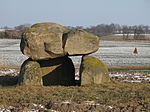The Rya Formation (Swedish: Ryaformationen) is a geologic formation in Skåne County, southern Sweden. It is Early to early Middle Jurassic (early Sinemurian to late Aalenian) in age. The Rya Formation comprises siltstones, claystones, sandstones, mudstones and rare coal beds. The formation overlies the Höganäs Formation and is overlain by the Vilhelmsfält and Mariedal Formations.
The formation was deposited in the Höganäs and Øresund Basins that formed in the earliest Jurassic as part of the break-up of Pangea. The 295 metres (968 ft) thick formation comprises four members, from base to top the Döshult, Pankarp, Katslösa and Rydebäck Members. The depositional environment of the formation ranges from continental to open marine.
The Rya Formation has provided fossils of a number of sharks, ammonites, bivalves and ichnofossils. Coalified wood occurs as scattered pieces up to 6 centimetres (2.4 in) long and indeterminate belemnites, echinoids, serpulids, ostracods and nodosariid foraminifera were also recorded in the formation. Iron ooids containing erratic boulders, called Geschiebe in German, attributed to the Rya Formation were found in Holstein, northern Germany.











